List of Governors of Florida
| Governor of Florida | |
|---|---|
|
| |
| Style | Mr. Governor |
| Residence | Florida Governor's Mansion |
| Term length | Four years, renewable once |
| Inaugural holder | William Dunn Moseley |
| Formation | 1845 |
| Deputy | Carlos López-Cantera, Lieutenant Governor |
| Salary | $130,273 (2013)[1] |
| Website | www.flgov.com |
The Governor of Florida is the head of the executive branch of Florida's state government and the commander-in-chief of the state's military forces.[2] The governor has a duty to enforce state laws, and the power to either approve or veto bills passed by the Florida Legislature,[3] to convene the legislature,[4] and to grant pardons, except in cases of impeachment.[5]
When Florida was first acquired by the United States, future president Andrew Jackson served as its military governor. Florida Territory was established in 1822, and five people served as governor over six distinct terms. The first territorial governor, William Pope Duval, served 12 years, the longest of any governor to date.
Since statehood in 1845 there have been 43 people who have served as governor, one of whom served two distinct terms. Three state governors have served two full four-year terms: William D. Bloxham, in two stints; and Reubin Askew and Jeb Bush, who each served their terms consecutively. Bob Graham almost served two terms, as he resigned with only three days left. The shortest term in office belongs to Wayne Mixson, who served three days following the resignation of his predecessor.
The current governor is Rick Scott, who took office on January 4, 2011, following the 2010 election. He was re-elected in 2014, and his second term began in January 2015.
Governors
Military governor
- For the a list of governors before Florida became a United States territory, see the list of colonial governors of Florida.
Spanish Florida was acquired from Spain in the Adams–Onís Treaty, which took effect July 10, 1821.[6] Parts of West Florida had already been assigned to Alabama, Louisiana, and Mississippi; the remainder and East Florida were governed by the commander of the military force that had helped secure American influence in the region.
| Picture | Governor | Took office | Left office | Appointed by | Notes |
|---|---|---|---|---|---|
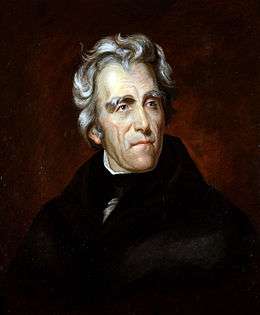 |
Andrew Jackson | March 10, 1821 | December 31, 1821 | James Monroe | [lower-alpha 1][lower-alpha 2] |
Governors of the Territory of Florida
Florida Territory was organized on March 30, 1822, combining East and West Florida.[11]
| Picture | Governor | Took office | Left office | Appointed by |
|---|---|---|---|---|
 |
William Pope Duval | April 17, 1822 | April 24, 1834 | James Monroe |
| John Quincy Adams | ||||
| Andrew Jackson | ||||
 |
John Eaton | April 24, 1834 | March 16, 1836 | Andrew Jackson |
 |
Richard K. Call | March 16, 1836 | December 2, 1839 | Andrew Jackson |
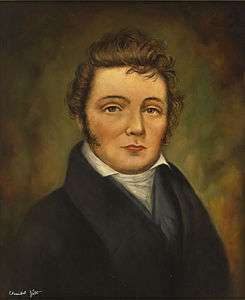 |
Robert R. Reid | December 2, 1839 | March 19, 1841 | Martin Van Buren |
 |
Richard K. Call | March 19, 1841 | August 11, 1844 | William Henry Harrison |
| John Tyler | ||||
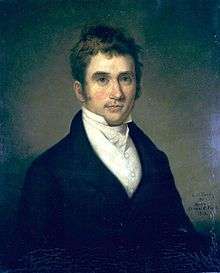 |
John Branch | August 11, 1844 | June 25, 1845 | John Tyler |
Governors of the State of Florida
The State of Florida was admitted to the Union on March 3, 1845. It seceded from the Union on January 10, 1861,[12] and joined the Confederate States of America on February 8, 1861,[13] as a founding member; there was no Union government in exile, so there was a single line of governors. Following the end of the American Civil War, it was part of the Third Military District.[14] Florida was readmitted to the Union on June 25, 1868.[15]
The first Florida Constitution, ratified in 1838, provided that a governor be elected every four years, who was not allowed to serve consecutive terms.[16] The secessionist constitution of 1861 would have reduced this to two years and removed the term limit,[17] but the state fell to the Union before the first election under that constitution. The rejected constitution of 1865 and the ratified constitution of 1868 maintained the four-year term,[18][19] though without the earlier term limit, which was reintroduced in the 1885 constitution.[20] The current constitution of 1968 states that should the governor serve, or would have served had he not resigned, more than six years in two consecutive terms, he cannot be elected to the succeeding term.[21] The start of a term was set in 1885 at the first Tuesday after the first Monday in the January following the election,[20] where it has remained.[22]
Originally, the president of the state senate acted as governor should that office be vacant.[23] The 1865 and 1868 constitutions created the office of lieutenant governor,[24][25] who would similarly act as governor. This office was abolished in 1885, with the president of the senate again taking on that duty.[26] The 1968 constitution recreated the office of lieutenant governor, who now becomes governor in the absence of the governor.[27] The governor and lieutenant governor are elected on the same ticket.[21]
Florida was a strongly Democratic state before the Civil War, electing only candidates from the Democratic and Whig parties. It elected three Republican governors following Reconstruction, but after the Democratic Party re-established control, 90 years passed before voters chose another Republican.
- Parties
Democratic (34) Independent (1)[lower-alpha 3] Prohibition (1) Provisional (1) Republican (8)[lower-alpha 3] Whig (1)
| #[lower-alpha 4] | Portrait | Governor | Term start | Term end | Party | Term[lower-alpha 5] | Lt. Governor[lower-alpha 6][lower-alpha 7] | ||
|---|---|---|---|---|---|---|---|---|---|
| 1 | 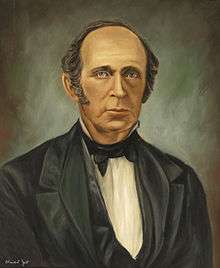 |
William Dunn Moseley | June 25, 1845 | October 1, 1849 | Democratic | 1 | Office did not exist | ||
| 2 |  |
Thomas Brown | October 1, 1849 | October 3, 1853 | Whig | 2 | |||
| 3 |  |
James E. Broome | October 3, 1853 | October 5, 1857 | Democratic | 3 | |||
| 4 |  |
Madison S. Perry | October 5, 1857 | October 7, 1861 | Democratic | 4 | |||
| 5 | 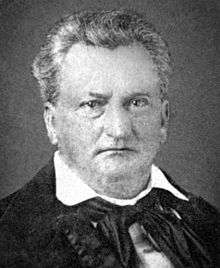 |
John Milton | October 7, 1861 | April 1, 1865 | Democratic | 5[lower-alpha 8] | |||
| 6 |  |
Abraham K. Allison | April 1, 1865 | May 19, 1865 | Democratic | ||||
| — | Interregnum | May 19, 1865 | July 13, 1865 | — | |||||
| 7 |  |
William Marvin | July 13, 1865 | December 20, 1865 | Provisional | 6[lower-alpha 9] | |||
| 8 |  |
David S. Walker | December 20, 1865 | July 4, 1868 | Democratic[lower-alpha 10] | William W. J. Kelly[lower-alpha 11] | |||
| 9 | 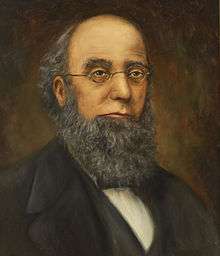 |
Harrison Reed | July 4, 1868 | January 7, 1873 | Republican | 7[lower-alpha 12] | William Henry Gleason[lower-alpha 13] | ||
| Vacant | |||||||||
| Edmund C. Weeks[lower-alpha 14] | |||||||||
| Samuel T. Day | |||||||||
| 10 |  |
Ossian B. Hart | January 7, 1873 | March 18, 1874 | Republican | 8[lower-alpha 15] | Marcellus Stearns | ||
| 11 |  |
Marcellus Stearns | March 18, 1874 | January 2, 1877 | Republican | Vacant | |||
| 12 |  |
George Franklin Drew | January 2, 1877 | January 4, 1881 | Democratic | 9 | Noble A. Hull[lower-alpha 16] | ||
| Vacant | |||||||||
| 13 |  |
William D. Bloxham | January 4, 1881 | January 7, 1885 | Democratic | 10 | Livingston W. Bethel | ||
| 14 |  |
Edward A. Perry | January 7, 1885 | January 8, 1889 | Democratic | 11 | Milton H. Mabry | ||
| 15 |  |
Francis P. Fleming | January 8, 1889 | January 3, 1893 | Democratic | 12 | Office did not exist | ||
| 16 | 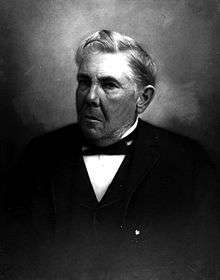 |
Henry L. Mitchell | January 3, 1893 | January 5, 1897 | Democratic | 13 | |||
| 17 |  |
William D. Bloxham | January 5, 1897 | January 8, 1901 | Democratic | 14 | |||
| 18 |  |
William Sherman Jennings | January 8, 1901 | January 3, 1905 | Democratic | 15 | |||
| 19 |  |
Napoleon B. Broward | January 3, 1905 | January 5, 1909 | Democratic | 16 | |||
| 20 |  |
Albert W. Gilchrist | January 5, 1909 | January 7, 1913 | Democratic | 17 | |||
| 21 |  |
Park Trammell | January 7, 1913 | January 2, 1917 | Democratic | 18 | |||
| 22 |  |
Sidney Johnston Catts | January 2, 1917 | January 4, 1921 | Prohibition | 19 | |||
| 23 |  |
Cary A. Hardee | January 4, 1921 | January 6, 1925 | Democratic | 20 | |||
| 24 |  |
John W. Martin | January 6, 1925 | January 8, 1929 | Democratic | 21 | |||
| 25 |  |
Doyle E. Carlton | January 8, 1929 | January 3, 1933 | Democratic | 22 | |||
| 26 |  |
David Sholtz | January 3, 1933 | January 5, 1937 | Democratic | 23 | |||
| 27 |  |
Fred P. Cone | January 5, 1937 | January 7, 1941 | Democratic | 24 | |||
| 28 |  |
Spessard Holland | January 7, 1941 | January 2, 1945 | Democratic | 25 | |||
| 29 |  |
Millard F. Caldwell | January 2, 1945 | January 4, 1949 | Democratic | 26 | |||
| 30 |  |
Fuller Warren | January 4, 1949 | January 6, 1953 | Democratic | 27 | |||
| 31 |  |
Daniel T. McCarty | January 6, 1953 | September 28, 1953 | Democratic | 28[lower-alpha 17] | |||
| 32 |  |
Charley Eugene Johns | September 28, 1953 | January 4, 1955 | Democratic | ||||
| 33 | 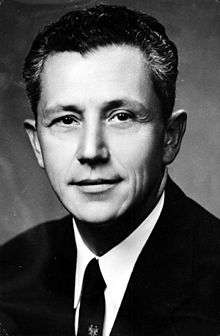 |
LeRoy Collins | January 4, 1955 | January 3, 1961 | Democratic | ||||
| 29 | |||||||||
| 34 |  |
C. Farris Bryant | January 3, 1961 | January 5, 1965 | Democratic | 30 | |||
| 35 |  |
W. Haydon Burns | January 5, 1965 | January 3, 1967 | Democratic | 31[lower-alpha 18] | |||
| 36 |  |
Claude R. Kirk, Jr. | January 3, 1967 | January 5, 1971 | Republican | 32 | |||
| Ray C. Osborne | |||||||||
| 37 |  |
Reubin Askew | January 5, 1971 | January 2, 1979 | Democratic | 33 | Thomas Burton Adams, Jr. | ||
| 34 | Jim Williams | ||||||||
| 38 |  |
Bob Graham | January 2, 1979 | January 3, 1987 | Democratic | 35 | Wayne Mixson | ||
| 36[lower-alpha 19] | |||||||||
| 39 | 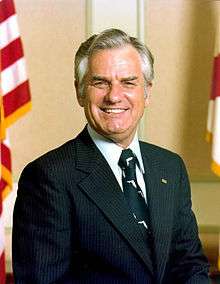 |
Wayne Mixson | January 3, 1987 | January 6, 1987 | Democratic | Vacant | |||
| 40 |  |
Bob Martinez | January 6, 1987 | January 8, 1991 | Republican | 37 | Bobby Brantley | ||
| 41 | 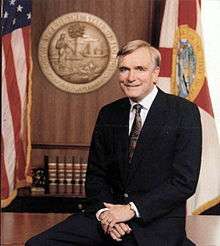 |
Lawton Chiles | January 8, 1991 | December 12, 1998 | Democratic | 38 | Buddy MacKay | ||
| 39[lower-alpha 20] | |||||||||
| 42 |  |
Buddy MacKay | December 12, 1998 | January 5, 1999 | Democratic | Vacant | |||
| 43 | 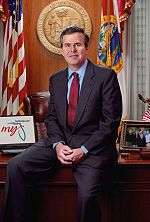 |
Jeb Bush | January 5, 1999 | January 2, 2007 | Republican | 40 | Frank Brogan[lower-alpha 21] | ||
| 41 | |||||||||
| Toni Jennings | |||||||||
| 44 |  |
Charlie Crist | January 2, 2007 | January 4, 2011 | Republican | 42 | Jeff Kottkamp[lower-alpha 11] | ||
| Independent[lower-alpha 22] | |||||||||
| 45 | .jpg) |
Rick Scott | January 4, 2011 | Incumbent | Republican | 43 | Jennifer Carroll[lower-alpha 23] | ||
| Vacant | |||||||||
| Carlos López-Cantera | |||||||||
| 44[lower-alpha 24] | |||||||||
Other high offices held
Fourteen of Florida's governors have served in federal offices, including one President of the United States, two Cabinet secretaries, and one ambassador. One served as Governor of North Carolina, and all fourteen were elected to the U.S. Congress, though only nine represented Florida, and only seven actually took their seats. One died before taking office, and the other was refused his seat by the U.S. Senate shortly after the American Civil War, because Florida had not yet been reconstructed. One governor (marked with *) resigned to take his seat in the Senate.
| Governor | Gubernatorial term | Other offices held | Source |
|---|---|---|---|
| Andrew Jackson | 1821 | Representative and Senator from Tennessee, President of the United States | [40] |
| William Pope Duval | 1822–1834 | Representative from Kentucky | [41] |
| John Eaton | 1834–1836 | Senator from Tennessee, Minister to Spain, Secretary of War | [42] |
| Richard K. Call | 1836–1839 1841–1844 |
Territorial Delegate from Florida Territory | [43] |
| Robert R. Reid | 1839–1841 | Representative from Florida, Representative from Georgia | [44] |
| John Branch | 1844–1845 | Representative and Senator from North Carolina, Governor of North Carolina, Secretary of the Navy | [45] |
| William Marvin | 1865 | Elected to the Senate from Florida but was refused seat | [46] |
| Napoleon B. Broward | 1905–1909 | Elected to the Senate from Florida but died before taking office | [47] |
| Park Trammell | 1913–1917 | Senator from Florida | [48] |
| Spessard Holland | 1941–1945 | Senator from Florida | [49] |
| Millard F. Caldwell | 1945–1949 | Representative from Florida | [50] |
| Bob Graham | 1979–1987 | Senator from Florida* | [51] |
| Lawton Chiles | 1991–1998 | Senator from Florida | [52] |
| Buddy MacKay | 1998–1999 | Representative from Florida | [53] |
Living former U.S. governors of Florida
As of May 2015, there are six former governors who are currently living at this time, the oldest U.S. governor of Florida being Wayne Mixson (1987, born 1922). The most recent death of a former U.S. governor of Florida was that of Reubin Askew (1971–1979), on March 13, 2014. The most recently serving U.S. governor of Florida to die was Lawton Chiles, who died in office on December 12, 1998.
| Governor | Gubernatorial term | Date of birth (and age) |
|---|---|---|
| Bob Graham | 1979–1987 | November 9, 1936 |
| Wayne Mixson | 1987 | June 16, 1922 |
| Bob Martinez | 1987–1991 | December 25, 1934 |
| Buddy MacKay | 1998–1999 | March 22, 1933 |
| Jeb Bush | 1999–2007 | February 11, 1953 |
| Charlie Crist | 2007–2011 | July 24, 1956 |
Line of Succession
Since 2003, the line of succession to the office of Governor has been as follows:[54]
- Lieutenant Governor, currently Carlos López-Cantera
- Attorney General, currently Pam Bondi
- Chief Financial Officer, currently Jeff Atwater
- Commissioner of Agriculture, currently Adam Putnam
If a vacancy occurs in the office of Governor and a successor within the above-stated line of succession can not fill the vacancy, the Speaker of the Florida House of Representatives and the President of the Senate must convene the Legislature by joint proclamation within 15 days for the purpose of choosing a person to serve as Governor for the remainder of the term. A successor can only be chosen by a majority vote in a joint session of both houses.[55]
If, after the appointment of a Lieutenant Governor, a vacancy occurs in the office of Governor with more than 28 months remaining in the term and the appointed Lieutenant Governor becomes Governor, voters must choose a governor and lieutenant governor to serve out the remainder of the terms at the next general election.
Notes
- ↑ Jackson's official titles were "Commissioner of the United States" and "Governor of East and West Florida".[7]
- ↑ Jackson left Florida on October 8, 1821.[8] His resignation was submitted on November 13, 1821,[9] and the president accepted it on December 31, 1821.[10]
- ↑ The official numbering includes repeat terms, as well as the provisional governor.
- ↑ Each term for which a governor is elected is listed here; if multiple governors served in a single term, due to resignations, deaths, and the like, then that term will be shared among those governors. If a governor was elected multiple times, then there will be multiple terms listed for that governor.
- ↑ The office of lieutenant governor was created in 1868, abolished in 1885, and recreated in 1968.
- ↑ Lieutenant governors represented the same party as their governor unless noted.
- ↑ Milton died in office, having committed suicide due to the pending defeat of the Confederate States of America, stating in his final address to the legislature that "death would be preferable to reunion."[28] As president of the senate, Allison acted as governor until he resigned to go into hiding from approaching Union troops, and was captured by them on June 19, 1865.[29] Following his resignation, Florida was without governance until a federal governor was appointed.
- ↑ Marvin and Walker were appointed by President Andrew Johnson following the American Civil War.
- ↑ Most sources state Walker was a Democrat; the state archives say he was "Conservative".[30]
- 1 2 Represented the Republican Party.
- ↑ Reed was popularly elected under the terms of the 1868 constitution, and took the oath of office on June 8, 1868; it was not until July 4, 1868, however, that the federal commander of Florida, still under Reconstruction, recognized the validity of the state constitution and the election.[31]
- ↑ During an attempted impeachment of Reed, Gleason proclaimed himself governor. The Supreme Court eventually sided with Reed, and Gleason was removed from office.[32]
- ↑ Appointed as temporary lieutenant governor to replace William Henry Gleason. However, the state comptroller did not believe the governor could appoint a replacement to an elected office and refused to pay Weeks, and the Senate refused to accept his presidency over them, even proposing a motion to arrest him. Governor Reed called for a special election to replace him, and though Weeks fought it, the Florida Supreme Court declared his term to have ended when the new election results were certified.[33]
- ↑ Hart died in office. As lieutenant governor, Stearns acted as governor for the remainder of the term.
- ↑ Resigned to take an elected seat in the United States House of Representatives; however, his election was successfully contested by Horatio Bisbee, Jr.[34]
- ↑ McCarty died in office. As president of the senate, Johns acted as governor until a special election, in which Collins was chosen.[35]
- ↑ Burns' term was only two years as the election schedule was changed so that it would not coincide with presidential elections.[36]
- ↑ Graham resigned to take an elected seat in the United States Senate. As lieutenant governor, Mixson became governor.
- ↑ Chiles died in office; as lieutenant governor, MacKay became governor.
- ↑ Resigned to become president of Florida Atlantic University.[37]
- ↑ Crist was elected as a member of the Republican Party, and switched to independent in April 2010.[38]
- ↑ Resigned amid a racketeering probe.[39]
- ↑ Governor Scott's second term expires on January 8, 2019; he will be term limited.
References
- General
- "Governors of Florida". National Governors Association. Archived from the original on March 25, 2010. Retrieved March 31, 2010.
- "A Guide to Florida Governors and the Florida Cabinet". State Library and Archives of Florida. Retrieved April 19, 2015.
- Constitutions
- "Constitution of the State of Florida". Florida Legislature. 1968. Retrieved March 31, 2010.
- "Constitution of 1885". State Library and Archives of Florida. 1885. Retrieved April 19, 2015.
- "Constitution of 1868". State Library and Archives of Florida. 1868. Retrieved April 19, 2015.
- "Constitution of 1865". State Library and Archives of Florida. 1865. Retrieved April 19, 2015.
- "Constitution of the State of Florida". State Library and Archives of Florida. 1868. Archived from the original on April 6, 2010. Retrieved April 19, 2015.
- "Constitution of 1838". State Library and Archives of Florida. 1838. Retrieved April 19, 2015.
- Specific
- ↑ "CSG Releases 2013 Governor Salaries". The Council of State Governments. June 25, 2013. Retrieved November 23, 2014.
- ↑ FL Const. art. IV, § 1a
- ↑ FL Const. art. III, § 8
- ↑ FL Const. art. III, § 3c
- ↑ FL Const. art. IV, § 8
- ↑ "Adams-Onís Treaty". Encyclopedia of Oklahoma History & Culture. Oklahoma Historical Society. Retrieved July 6, 2010.
- ↑ "Andrew Jackson". State Library and Archives of Florida. Archived from the original on February 2, 2010. Retrieved July 6, 2010.
- ↑ Morris, Allen; Joan Perry Morris (1999). The Florida Handbook, 1999–2000. Peninsular Books. ISBN 978-0-9616000-7-5. Retrieved July 6, 2010.
- ↑ Harold D. Moser, David R. Hoth, George H. Hoemann, ed. (1996). The Papers of Andrew Jackson: 1821–1824. University of Tennessee Press. p. 513. ISBN 0-87049-897-5. Retrieved July 6, 2010.
- ↑ Stanislaus Murray Hamilton, ed. (1902). The Writings of James Monroe. G.P. Putnam's Sons. p. 207. Retrieved July 6, 2010.
- ↑ Peters, Virginia Bergman (1979). The Florida Wars. Hamden: The Shoestring Press. pp. 63–74. ISBN 0-208-01719-4.
- ↑ "Florida and the Civil War" A Short History". Florida Memory. State Library & Archives of Florida. Archived from the original on April 26, 2010. Retrieved July 5, 2010.
- ↑ "February 1861–1865". This Day in History. Florida Historical Society. Retrieved July 6, 2010.
- ↑ Cox, Merlin (January 1968). "Military Reconstruction in Florida". Florida Historical Quarterly 46 (3): 219.
- ↑ "June in Florida History". This Day in History. Florida Historical Society. Retrieved July 6, 2010.
- ↑ 1838 Const. art III, § 2
- ↑ 1861 Const. art. III, § 2
- ↑ 1865 Const. art. III, § 2
- ↑ 1868 Const. art. V, § 2
- 1 2 1885 Const. art. IV, § 2
- 1 2 FL Const. art. IV, § 5
- ↑ FL Const. art. IV, § 2
- ↑ 1838 Const. art III, § 18
- ↑ 1865 Const. art. III, § 19
- ↑ 1868 Const. art. V, § 15
- ↑ 1885 Const. art. IV, § 19
- ↑ FL Const. art. IV, § 3
- ↑ "Florida Governor John Milton". National Governors Association. Retrieved March 30, 2010.
- ↑ "Florida Governor Abraham Kurkindolle Allison". National Governors Association. Retrieved March 30, 2010.
- ↑ "David Shelby Walker". State Library and Archives of Florida. Archived from the original on January 23, 2011. Retrieved July 6, 2010.
- ↑ "Florida Governors' Portraits – Harrison Reed". Museum of Florida History. Retrieved March 30, 2010.
- ↑ Davis, William Watson (1913). The Civil War and Reconstruction in Florida, Volume 53. Columbia University. pp. 550–555. Retrieved July 6, 2010.
- ↑ Cases argued and adjudged in the Supreme Court of Florida XIII. State of Florida. 1871. Retrieved July 6, 2010.
- ↑ "Hull, Noble Andrew". Biographical Directory of the United States Congress. Retrieved July 6, 2010.
- ↑ "Florida Governor Thomas Leroy Collins". National Governors Association. Retrieved March 30, 2010.
- ↑ "Florida Governor Haydon Burns". National Governors Association. Retrieved March 30, 2010.
- ↑ "Jeb's Boy". Broward-Palm Beach New Times (Ft. Lauderdale). Retrieved July 14, 2010.
- ↑ "Can Crist Win in Florida as an Independent?". Time. May 3, 2010. Retrieved July 14, 2010.
- ↑ Rachel Weiner (March 13, 2013). "Florida Lt. Gov. resigns amid racketeering probe". The Washington Post. Retrieved March 16, 2013.
- ↑ "Jackson, Andrew". Biographical Directory of the United States Congress. Retrieved April 3, 2010.
- ↑ "Duval, William Pope". Biographical Directory of the United States Congress. Retrieved April 3, 2010.
- ↑ "Eaton, John Henry". Biographical Directory of the United States Congress. Retrieved April 3, 2010.
- ↑ "Call, Richard Keith". Biographical Directory of the United States Congress. Retrieved April 3, 2010.
- ↑ "Reid, Robert Raymond". Biographical Directory of the United States Congress. Retrieved April 3, 2010.
- ↑ "Branch, John". Biographical Directory of the United States Congress. Retrieved April 3, 2010.
- ↑ "Florida Governor William Marvin". National Governors Association. Archived from the original on April 2, 2010. Retrieved April 3, 2010.
- ↑ "Florida Governor Napoleon Bonaparte Broward". National Governors Association. Archived from the original on April 2, 2010. Retrieved April 3, 2010.
- ↑ "Trammell, Park". Biographical Directory of the United States Congress. Retrieved April 3, 2010.
- ↑ "Holland, Spessard Lindsey". Biographical Directory of the United States Congress. Retrieved April 3, 2010.
- ↑ "Caldwell, Millard Fillmore". Biographical Directory of the United States Congress. Retrieved April 3, 2010.
- ↑ "Graham, Daniel Robert (Bob)". Biographical Directory of the United States Congress. Retrieved April 3, 2010.
- ↑ "Chiles, Lawton Mainor, Jr.". Biographical Directory of the United States Congress. Retrieved April 3, 2010.
- ↑ "MacKay, Kenneth Hood, Jr. (Buddy)". Biographical Directory of the United States Congress. Retrieved April 3, 2010.
- ↑ "States' Lines of Succession of Gubernatorial Powers" (PDF). National Emergency Management Association (NEMA). May 2011. Retrieved March 27, 2015.
- ↑ "Succession to office of Governor". The Florida Legislature. Retrieved May 1, 2015.
| ||||||||||||||||
| ||||||
| ||||||||||||||||||

